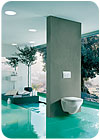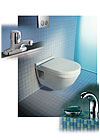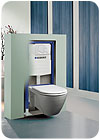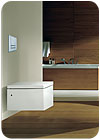
Everyone understands that water is essential to life. But many are only just now beginning to grasp how essential it is to everything in life - food, energy, transportation, nature, leisure, identity, culture, social norms and virtually all the products used on a daily basis. One of the most critical challenges is how to sustain our potable water and wastewater infrastructure to ensure that everyone can continue to enjoy these benefits in the future.
Quality of life can be improved on a sustainable basis through innovative solutions in plumbing technology. In fact, efficient water use is the key to sustainable development.
Water conservation and our care for the environment are reflected in how we design with water-efficient plumbing technology. Water efficiency is an opportunity to expand the plumbing landscape. Helping to integrate efficiency into total building design, sustainable design has been made easier with guidance and building-environmental-design tools.
Design ToolsDesign tools are a starting point to effectively incorporate environmental responsibility into building structures. The role of design tools is to give a broad overview and get the design team to go through the sustainable ideas, think about what they mean, and determine how to integrate them into the building. Indoor water-reduction strategies that include indoor plumbing fixture use are part of these efforts. Each guideline requires indoor water usage be reduced by 20% or more from the EPAct guideline.
The U.S. Green Building Council’s (USGBC) Leadership in Energy and Environmental Design (LEED) Green Building Rating System™ program is among the dominant design tools used to rate a building’s sustainability performance in the United States. The wider public appreciation for the threat of global warming has moved LEED into the mainstream. Two federal agencies, 22 states and 75 localities from Seattle to Boston have instituted policies to require or encourage LEED.
The system encourages and accelerates adoption of sustainable building practices through the creation and implementation of universally understood and accepted tools and performance criteria. In the form of credits for sustainable site development, water savings, energy efficiency, materials selection, indoor environmental quality, and process and innovation, points are awarded for credits achieved, with a total of 69 points possible. Forty percent of these points must be achieved to gain certification, which includes four progressive levels: Certified, Silver, Gold and Platinum.
Public recognition of climate change has inspired even more ambitious efforts. The Living Building Challenge, which seeks “to define the highest measure of sustainability possible in the built environment,” trades LEED’s checklist approach for a number of prerequisites: meeting all of a building’s energy, water, and water-disposal needs on-site, for example, or purchasing credits to offset the carbon footprint. USGBC has endorsed the effort, which was devised by the Cascadia Region Green Building Council.
Another player gaining momentum with formal legislation in 11 states is Green Globes, which originated in Canada and has expanded into the U.S. nonresidential building market. It is the first interactive, Web-based, commercial green building assessment protocol and the only Web-based assessment that guides the integration of green principles into a building’s design. The Green Globes system includes a rating system and guide for integrating environmentally friendly design by identifying a building’s environmental strengths and weaknesses, instantly recommending sustainable design improvements, and automatically generating links to engineering, design and product sources.
Then there is the EPA WaterSense® Program that stands on its own and is also incorporated in most design tools. The WaterSense program is set up to protect the future of our nation’s water supply by encouraging smart water use and bringing the use of water-efficient products to market. It offers many resources for efficiency in municipal, commercial and residential use, including guidelines for water conservation plans, references on drought management, conservation pricing and high-efficiency toilets and residential water conservation techniques.
The primary means of reducing indoor water use as indicated in all of the mentioned design tools has to do with the fittings being used. In most buildings, plumbing fittings provide essential services that cannot be reduced: bathing, hand washing and sewage conveyance. In all of these applications, the water consumption depends on usage patterns and consumption per use. Usage patterns are largely a matter of personal preference. For the most part, lowering water use in plumbing fittings means improving plumbing technology to lower the consumption per use. For flow-type fittings, this means lowering the gallons per minute (gpm), and for flush-type fittings, lowering the gallons per flush (gpf). In essence, it’s all about getting the same or better service for less water by using better technology.

Water-efficient
plumbing technology makes water conservation attainable and helps achieve
sustainable building goals. Source: Geberit and Chicago Faucets.
Technology Advances
Having the design tools makes it easier to plan more water-efficient approaches, but how these concepts are mainstreamed is what’s vital moving forward. To bring it into focus, the average American uses 100 gallons of water every day. Broken down further, Americans consume almost 4.8 billion gallons of water daily by flushing toilets and urinals. In a business office setting, flushing alone can account for approximately one-third of all water used. Water use can be reduced by as much as 30% by taking a few simple steps, such as installing high-efficiency plumbing fittings.Manufacturers have made major advances in improving the ease of use and the water efficiency of restroom fittings. Today’s innovative, water-efficient plumbing systems make water conservation attainable and help achieve sustainable building goals. Plumbing innovations such as high-efficiency dual-flush toilets help empower users to manage water shortages. The transition of these fixtures from commercial to residential adaptation offer the potential to decrease total water demands by increasing efficient water use by end users, without negatively impacting the quality of life.
The high-efficiency dual-flush toilet makes it possible to regulate the flushing volume and enables users to use considerably less potable water for flushing. The basic concept is simple. There are two modes of flushing waste down the toilet: one full flush for solid wastes that uses the standard 1.6 gpf, and one low flush for liquid wastes that typically uses half of the full flush, or about 0.8 to 1.1 gpf. Following the LEED calculations guide of a 2:1 ratio of low to full flush, the flush rate can be calculated to 1.28 gpf, falling under WaterSense’s definition of a High Efficiency Toilet.
The dual-flush toilets can be disguised in the form of the standard tank-type toilet. The only visible difference is that the handle or the flushing mechanism looks and functions differently. There are newer models that mount the toilet on the wall, taking it off the floor, and having the tank system behind the wall. It is safely hidden in the wall and operated only by activation plates for two flush volumes. Because it is “in the wall,” the actuator flush panel also serves as the doorway to the system’s moving parts - allowing easy access to all flushing components and the shut-off valve.
If space is an issue, wall-hung toilets can save as much as 9" in front of the toilet. For a small bathroom, the wall-hung toilet does two things. First, it physically doesn’t take up as much space. Second, it gives a feeling of spaciousness. When the floor stops at the front of the toilet, you feel that is how big the bathroom is; however, when it goes beyond the toilet (as it does in the wall-hung designs), it carries your eyes. The room looks bigger, giving the impression of spaciousness.

The Concealed Tank and Carrier System conceals the
functional components behind the wall while retaining reliability, performance
and easy maintenance features. The water-saving option is provided through
dual-flush technology: 0.8 gpf (3 lpf) or 1.6 gpf (6 lpf) consumption. Source:
Geberit.
Water Savings
To illustrate the water saving potential of these toilets, consider that the average person in this country flushes the toilet about five times per day, according to the American Water Works Association. Most bathrooms these days have a toilet that flushes 1.6 gpf. That equals eight gallons per day, or 2,920 gallons per year, per person, just for toilet flushing.When using dual-flush toilets, almost all waste can be flushed with the liquid waste mode. Even if the full flush is used once a day and four other low flushes, that brings the total water use to 4.8 gallons per day or 1,752 gallons per year - a pretty significant savings in water (1,168 gallons per person). Just imagine the savings compared to an older toilet that uses 3.5 gallons or more to flush.
The dual-flush system puts sustainability at our fingertips. This is demonstrated by research conducted by the Canada Mortgage and Housing Corporation and Veritec Consulting of Ontario, Canada. They completed a comprehensive evaluation of dual-flush fixtures installed by 13 agencies in seven provinces across Canada. Study findings revealed no significant increase in flushing frequency with the installation of the dual-flush fixtures.
A component of this extensive study included the retrofit of a 15-unit Toronto apartment building with dual-flush fixtures. The replacement of existing high-volume fixtures (average 3.9 gpf) with dual-flush units yielded a water savings rate of nearly 12,000 gallons per year per apartment. The study also compared dual-flush fixtures with new 1.6-gpf fixtures and showed that the dual flush fixture used 23% - 32% less water than these conventional 1.6-gpf fixtures.
In addition, a Seattle Home Water Conservation Study, The Impacts of High Efficiency Plumbing Fixture Retrofits in Single Family Homes, conducted by the Seattle Public Utilities and The U.S. Environmental Protection Agency, evaluated water use patterns in 37 homes in the city before and after the retrofit of existing plumbing fixtures and appliances with high-efficiency models, including toilet fixtures, showerheads, faucets and clothes washers.
In total, 40 new dual-flush fixtures were installed in 20 homes, and 34 new conventional 1.6-gpf toilets were installed in the remaining 17 homes. Flushing frequency and flush volumes were measured. The total water savings from the dual-flush fixture installation amounted to 10,600 gallons per year per home, while replacement with a conventional 1.6-gpf fixture amounted to 9,000 gallons per year.

A behind-the-wall, dual-flush system makes it possible to
position components in any part of the bathroom, while concealing the
functional components. Source: Geberit.
Changing Habits
Possibly the most attractive feature of the dual flush is it does not require significant behavioral changes for their benefits to be realized. That is, end users can continue to use the toilet with the same frequency as they normally do and still save water, energy resources and money. Moreover, greater efficiency at the end-user level translates into resource and monetary benefits at the water utility level.Saving water also means saving costs for electric power, gas, chemicals and wastewater disposal. Efficient water use also can have major environmental, public health, and economic benefits by helping to improve water quality, maintain aquatic ecosystems, and protect drinking water resources. Efficient use of water, through behavioral, operational, or equipment changes, if practiced broadly, can help mitigate the effects of drought.